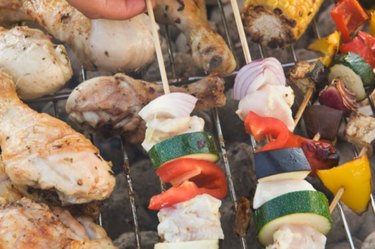
Today's home cooks have more choices than ever across every aspect of cooking, including a plethora of appliances. Sometimes, the terminology around cooking techniques can be confusing, especially because it can vary from region to region. Understanding the different ways in which foods can be cooked is key to making smart and delicious decisions, such as convection versus grill. The differences between grill and convection cooking methods are many and range from the type of heat source to the indoor versus outdoor setting. However, there's a surprisingly large overlap in the kinds of food suited to these dissimilar devices.
What Is Grilling?
Video of the Day
Grilling is probably the oldest cooking method used by humans, and it has changed very little since the Stone Age. Grilling means cooking over direct, dry heat, namely an open flame powered by charcoal, wood or gas, which is usually underneath an open metal grill. Temperatures for grilling can often exceed 500 degrees Fahrenheit, which makes it probably the fastest, hottest cooking method in common use today. It also necessitates an outdoor setting, leading grilling to be a popular choice for social events and summertime feasts. The major benefit of grilling is an unrivaled flavor and aroma with mouthwatering hints of smoke and intense browning.
Video of the Day
Grilling is best suited for leaner meats that can be thoroughly cooked in a short time as well as burgers, chops, sausages, firm fish, large shrimp and other seafood. Sturdier vegetables, such as bell peppers, zucchini, onions and mushrooms, are excellent candidates for grilling. You can also grill bite-size meat cuts and vegetables threaded onto skewers. These are just the most obvious items for grilling, though, and adventurous cooks often experiment with grilled fruits, breads, pizzas and other uncommon ideas.
What Grilling Is Not
The term "grilling" is often applied incorrectly to other cooking methods. It's easily confused with barbecuing, as the two techniques share the same types of appliances. However, barbecuing uses a lower cooking temperature and longer cooking time than grilling, and it is better suited to fattier cuts of meat. Broiling is similar to grilling in that it uses a direct, dry heat source to cook food from one side. Broiling uses a heat source above the food rather than below it. It is typically done with an indoor appliance, such as the broiler function on a gas or electric oven.
Electronic appliances and skillets with ridged cooking surfaces might have the word "grill" in their name, but using them is not really grilling because they cook with indirect heat. The darkened lines they create do resemble genuine grill marks, though.
What Is Convection Cooking?
One major difference between grills and convection ovens is that convection ovens are a relatively new technology. Countertop convection ovens and microwave/convection oven combos are available, and many conventional ovens come with a convection function. They work by circulating the oven's radiant heat with an internal fan, which provides a steady, even heat source all around the food. Compared to a conventional oven, convection ovens cook more quickly and evenly, ideally resulting in better browning, crisper exteriors and flakier pastries. Energy efficiency is another benefit of convection cooking.
Newcomers to convection ovens often experience a learning curve and need to use some trial and error to enjoy the benefits of the technique. When adjusting recipes from conventional ovens, start by lowering the temperature by about 25 degrees and cutting the cooking time by about a quarter. You might also seek out recipes that include specific instructions for convection cooking. Convection ovens are great for baking and roasting a huge range of foods, including all kinds of meat cuts and poultry, vegetables, pizzas and sweet and savory baked goods.
Convection vs. Grill
There are significant differences between grills and convection ovens, but for many foods, you could choose either one with success. Some key differences and similarities include:
- Convection ovens use indirect heat, while grilling uses direct heat.
- Grilling is always done outdoors, and convection ovens are always indoors. The weather is a key factor in deciding whether to choose convection cooking or grilling.
- Grills are powered by charcoal, gas or wood, whereas convection ovens are electric.
- Both are ideal for quickly cooking meats, seafood and vegetables, with greater browning than other cooking methods.
- Convection ovens are great for baking; grills are not.